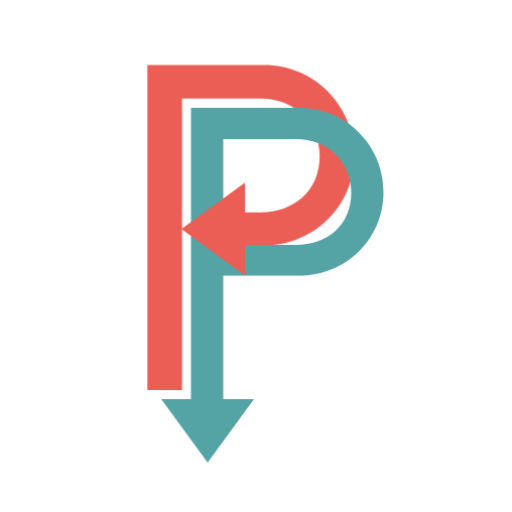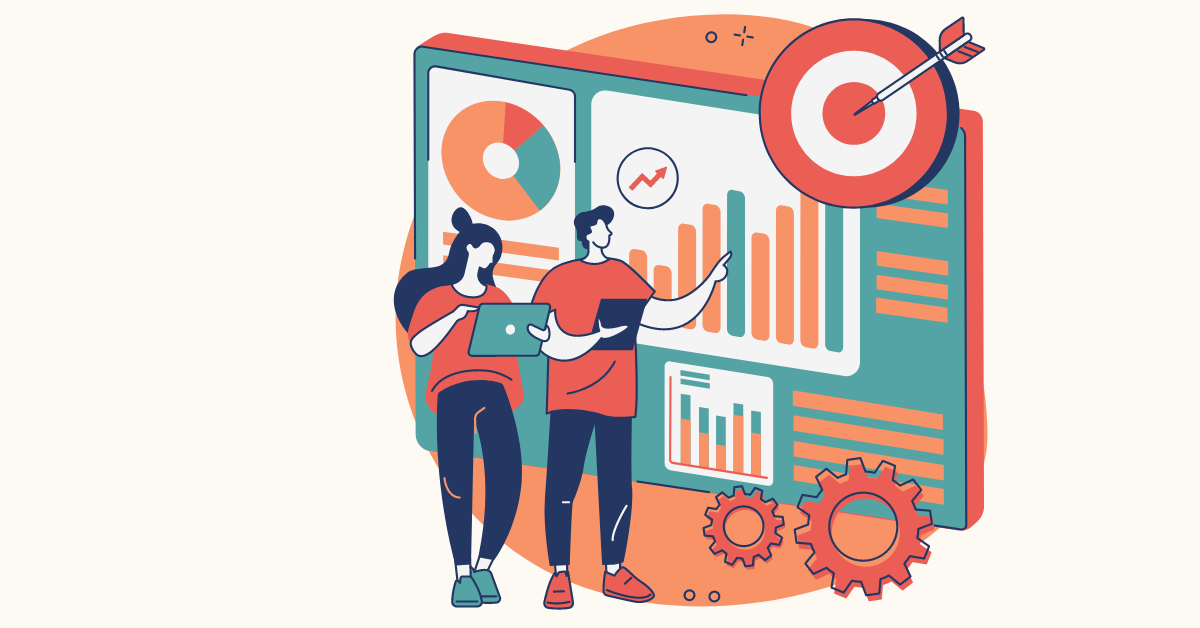Each project management framework contains three components. There’s the control cycle, the project’s lifecycle, and all the templates and tools the team uses.
I’ll discuss these items below. But, today’s focus will be on the most effective project management frameworks. I’ve tackled these frameworks’ methodology, pros, and cons.

Key Takeaways
- There are at least 20 different types of project management frameworks.
- The most popular project management frameworks are Waterfall, Agile, and all those created from the Agile model;
- Every framework has a specific lifecycle, a control cycle, tools, and templates – these are needed for project implementation;
- You should pick one of these alternatives based on certain aspects, including your business activity and the project’s size. Below, I’ve detailed all these elements.
Types of Project Management Frameworks – Top 20 Best Options
There are two main project management types: Waterfall and agile. But, since these two have appeared, many other sub-types have derived from them. Today, I will detail all these frameworks, including the modern alternatives.
Agile Framework
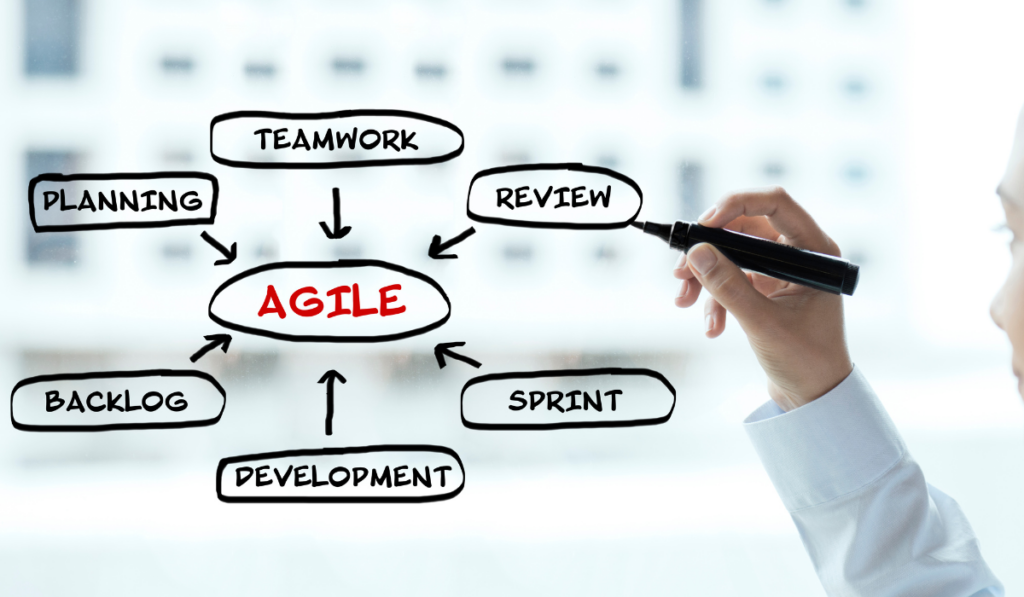
With Agile, each stage of the project has the same amount of time and equal execution phases. So, you must go through every step until you reach the final product or outcome.
This project management strategy focuses on improving every stage. It’s an iterative approach mainly used in software development.
How It Works
Instead of being a single solution to project management, Agile is more of a best practices collection that relies on tests, trials, and feedback loops.
Hence, the team members must develop constant collaboration for the project to work. The Agile framework includes planning, testing, executing, and integrating elements. All these are forms of continuous development.
Agile has five stages:
- Ideation – establishing goals and purposes; determining user requirements and business documentation; allocating resources;
- Development – production tasks, coding, UX/UI design, etc. It’s typically the longest Agile stage;
- Testing – verifying the code, conducting trial runs, and solving any bugs or errors;
- Deployment – placing the software on a cloud-based platform or an in-house server. By now, the new product is accessible to users;
- Operations – ongoing maintenance, user engagement, and further improvements.
The Agile Manifesto
Even though it is called Agile, the manifesto is a unifying statement for multiple project management frameworks, including Scrum and Extreme Programming. It’s very different from the Waterfall approach, but I’ll detail that later. This manifesto has the following values that everyone must respect:
- People and collaborations are significantly more important than tools or processes;
- Customer collaboration has a higher value than contract negotiation;
- Comprehensive documentation is not as crucial as working software;
- Following a plan should be done flexibly; team members must be willing to respond to change.
Benefits
- High customer satisfaction;
- Boosted flexibility;
- Timely delivery;
- Ease of collaboration;
- Stimulated creativity;
- Attention to detail;
- Transparency;
- Higher profits.
Downsides
- Lack of documentation;
- Less predictability;
- Potential workflow coordination issues;
- It lasts longer and has greater demands.
Lean Framework
Lean is derived from the Agile framework like Scrum, Kanban, and Extreme Programming. But, it has certain elements that are different from the Agile approach.
That’s why I decided to tackle each one separately. Through Lean, you can optimize the entire project, from those involved to resources, energy, and effort. And you can do all that while still creating value for your clients.
How It Works
Lean relies on respecting people and improving constantly. Moreover, this project management framework consists of five principles:
- Identifying value – the team should express value regarding a product that clients need. The project’s outcome must meet the client’s expectations regarding quality, timeline, and price;
- Mapping value stream – this refers to all the actions the employees must do. There are three types of tasks: problem-solving, information management, and physical transformation. In my experience, there are two maps: the first one, which is estimated, and the second one, which appears once the project is completed. That way, you can identify and eliminate waste;
- Creating flow – during this phase, one should improve lead time by creating a product-focused structure while also getting rid of functional barriers;
- Establishing pull – the pull strategy comes from marketing when the business allows clients to pull their desired products that meet their needs. That way, you won’t need a sales forecast;
- Seeking perfection – contrary to popular belief, the process has no end. Hence, you will always have to improve, review, and try again from the top. This is an attempt to create an even better product.
Benefits
- Eliminates waste;
- Boosts worker satisfaction;
- Gives your company competitive leverage;
- A more effective way of working;
- Added customer value;
- Lower costs;
- Increased quality;
- Using both push and pull strategies.
Downsides
- A low error margin;
- Lack of time;
- Working without a lot of direction;
- Inventory problems;
- Difficulties in changing the tactics.
Waterfall Framework
From the beginning to the end of a project, the Waterfall framework follows a linear progression. The Waterfall framework is mainly used to implement new software and IT programs. Compared to other PM methodologies, this one is easier to understand, follow, and complete.
How It Works
The original Waterfall framework relies on five project phases. The one I’ve listed below has six steps:
- Requirements and planning – establishing the goals and the proper way to achieve them;
- Analysis – feasibility studies, cost assessments, and additional requirements;
- Design – software architecture, frameworks, and detailed construction plans;
- Implementation – this stage includes troubleshooting, step-by-step integration, programming, and testing;
- Testing – to avoid or eliminate any flaws, the program goes through regular testing processes;
- Maintenance – once the new program is installed, maintenance begins. That consists of improvements, client support, and fixing bugs.
Since the first model appeared on the market, some upgrades have been made. Hence, a few modern Waterfall alternatives are now available, including those that consist of six or even seven stages.
During Waterfall implementation, each stage is seen as an isolated event. However, unlike Waterfall, Agile allows you to conduct several phases simultaneously.
Benefits
- Easy to understand;
- Easy to manage;
- Timescales are kept;
- No financial surprises;
- A very clear outcome;
- Clear structures;
- Information transfer is quickly done.
Downsides
- A rigid model – lack of flexibility;
- A bit challenging to define the requirements;
- Longer delivery time;
- You can’t make changes that easily;
- It doesn’t take into consideration the end user that much;
- Testing comes after implementation.
Scrum Framework
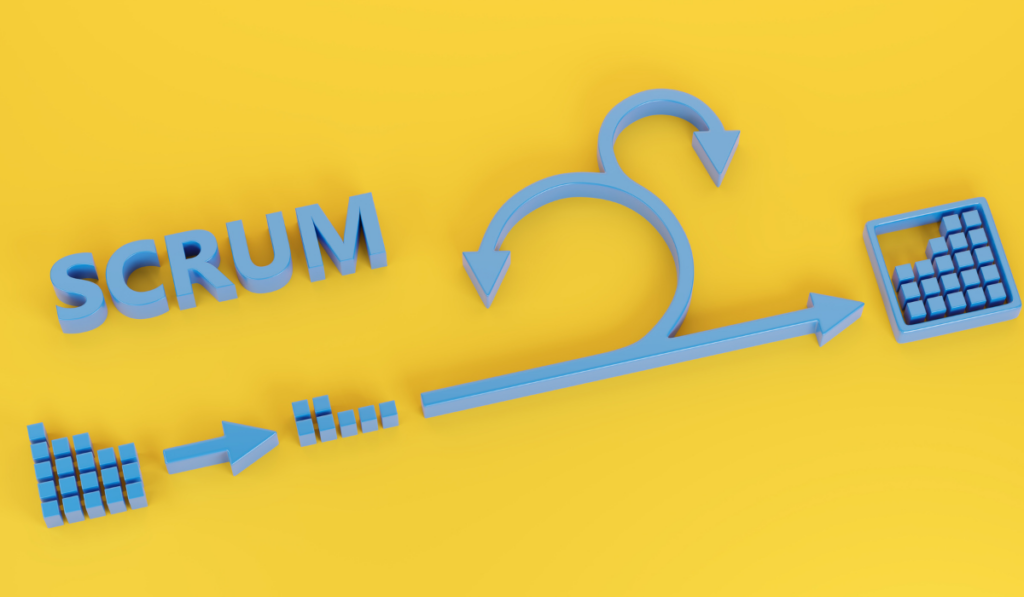
This technique focuses on incremental product delivery. It does that through collaborative decision-making and constant feedback. With Scrum, you can control requirements in no time. Most PM experts use time boxes, product backlog, collaborative ceremonies, and continuous feedback loops to achieve that.
How It Works
Scrum brings both stakeholders and clients to the center of the process. It enables them to review each stage and its outcome.
Due to Scrum’s stages, called sprints, a project could be completed in around one to four weeks. I would personally use this framework if my project is time-sensitive.
Here’s how Scrum works:
- Sprint planning meeting – this occurs the first day a new stage begins. Everyone, including the product owner, gets together to achieve a fruitful collaboration. The team determines the requirements, and they plan the tasks;
- Tracking progress – the team keeps track of the project’s progress through burndown charts and task boards. There will be three columns containing the things that must be done, undergoing tasks, and completed stages;
- Sprint review – stakeholders will review what has been done after every sprint. They will point out areas of improvement;
- Release planning – allows long-term planning during which the specialists offer estimates and solutions to the client.
Benefits
- Quick and efficient;
- Great for larger projects;
- Ideal for fast-moving development projects;
- Scrum meetings allow a high level of transparency and visibility;
- A lot of constructive feedback leads to better results;
- A creative approach;
- Low-cost.
Downsides
- A lack of an end date could mess up the process;
- All team members must be highly committed to the project;
- Scrum applied to larger teams could be challenging;
- It works best when the employees are experienced;
- Daily meetings might frustrate some employees.
IPM Framework
This stands for Integrated Pest Management. It’s a particular type of project dedicated to crops and agriculture. IPM helps farmers eliminate plant diseases and pests without using too many chemicals. This strategy relies on ecosystems, and the prevention method must have long-term results.
How It Works
There are five steps one must follow:
- Identification – not all living things encountered in crops are dangerous or damaging. This step helps you establish that;
- Monitoring – this step allows experts to see whether or not further treatment or intervention is necessary;
- Action thresholds – this is when the damage done by pests is seen as intolerable, which leads to action. Those involved take the initiative based on economic, medical, health, and legislative criteria;
- Testing treatment methods – while prevention is most desired, sometimes that’s not enough. That’s when treatments take place. They are cultural and sanitation, mechanical or physical, biological, and chemical. The last one involves the use of pesticides;
- Evaluation – through review and assessment, the process is improved. It allows the project to begin again (updated and upgraded).
Benefits
- Healthier crops due to lowered focus on pesticides;
- Achieving a balanced ecosystem;
- Biodiversity boost;
- Low or no pollution;
- Affordable;
- Long-term solution;
- Sustainable;
- Healthy plants.
Downsides
- A technical framework that requires niche experts;
- The strategy’s development needs a lot of time and effort;
- Financial constraints;
- Limited effectiveness;
- Lack of knowledge.
Prince2 Framework
This project management framework focuses on specific values:
- Business justification;
- Stage management;
- Learning from experience;
- Tailoring;
- Roles and responsibilities;
- Focusing on products;
- Managing by exception.
Knowing how Prince2 works will help you bring your project management career to the next level. It’s a generic method that teams can use in any department or industry. It includes best practices and has proven to be a practical framework.
How It Works
It consists of the following phases:
- Starting up – a new project appears, and it goes by the name of the project mandate. Once approved, the team goes on to the next stage;
- Initiation – the team comes up with a plan that entails things like expenses, timeline, resources, advantages, goals, quality, and risks;
- Managing the project – after every phase, there will be a review of that specific milestone and its outcome;
- Controlling – gathering progress data, authorizing tasks, implementing changes, reporting, reviewing, and taking corrective action if and when needed;
- Product delivery management – relieving on forecasts and the outcomes to see if the product meets the client’s requirements and the quality terms established in the beginning;
- Closing – this part includes reporting, paperwork, and the outcome;
- Planning and directing – there’s a lot of planning throughout the project: defining the products, creating the plan, preparing estimates, developing the schedule, documenting the plan, and analyzing the risks. The directing part goes on from the start till the project ends. One can achieve that through constant reporting and feedback.
Benefits
- High level of accountability;
- Practical and easy to adapt;
- Time-saving;
- Enables continuous improvement;
- Saving money;
- Extremely valuable;
- Easy to use alongside Agile methodologies.
Downsides
- The need for a lot of documentation could be daunting;
- Quite rigid;
- Requires trained specialists;
- Some phases might slow down the overall process.
Kanban Framework
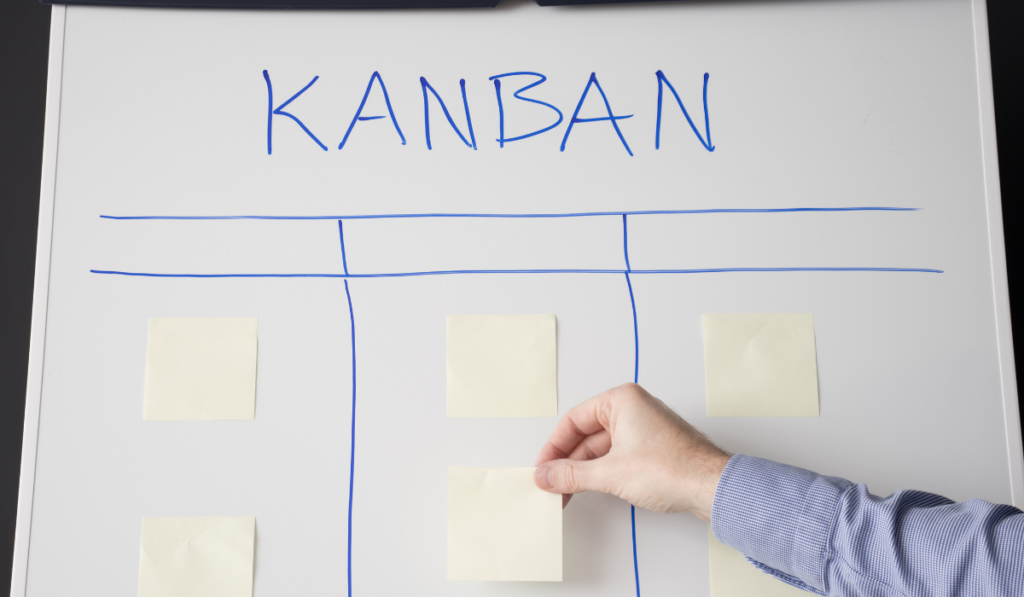
Kanban is part of the same family as Agile and Scump. It’s great for complex projects where Waterfall tactics fall short. Kanban was created in 1940 by Toyota. It was successful because it improved the company’s manufacturing efficiency. Kanban is very popular.
How It Works
It uses a signboard with columns. The system simplifies the process and monitoring tasks. Team members find it easier to follow those columns with things they have to do, tasks in progress, and actions that were already completed.
It focuses on visualization, workflow management, feedback loops, transparent policies, and collaborative evolution.
Kanban has the following elements:
- Visual signs;
- Work in progress;
- Columns – not started yet, in progress, in review, completed, etc.;
- Delivery point;
- Commitment point.
Here are Kanban’s stages:
- 0 – clear board;
- 1 – to-do list;
- 2 – actions that are in progress;
- 3 – things that are completed.
There could be an optional 4th stage – those tasks under review.
Benefits
- Reduced waste;
- Time-saving;
- Improved collaboration;
- Quick and effective;
- Boost quality;
- Transparent overview.
Downsides
- It cannot be used independently;
- Not suitable for too dynamic working environments;
- Iteration inability.
Scrumban Framework
This framework is a hybrid between Scrum and Kanban. Both are agile methodologies. But, while Scrum focuses on smaller teams, Kanban relies on continuous improvement.
Scrumbun brings the perks of these two frameworks together. This framework uses Scrum’s structure and completes it with Kanban’s flexibility.
How It Works
- Iterations – compared to Scrum, Scrumban has shorter iterations. Team members choose their desired tasks;
- On-demand planning – it’s a flexible process that works on the need-based concept;
- Bucket planning – there are three buckets (a one-year bucket for long-term objectives, a six-month bucket for management-approved plans, and a three-month bucket that divides the six-month program into smaller tasks);
- WIP limits – these rules minimize multitasking to boost productivity and performance;
- Task prioritization – each task receives an order number so that the employees know what to prioritize even when they choose their actions;
- Measuring success – Scrumban uses forecasting and charts to measure progress and outcomes.
Benefits
- Ideal for larger projects because it allows you to split them into smaller milestones;
- Enables transparency;
- Eliminates bottlenecks;
- Avoid confusion;
- Little documentation;
- Lowers lead time;
- Continuous workflow.
Downsides
- Doesn’t allow too many changes;
- Teams might lose velocity;
- Team managers have less control over the process.
Kaizen Framework
The standard Kaizen methodology has four stages, while the more complex alternative has six phases. Employees love implementing the Kaien method because it gives them a higher sense of purpose and boosts morale.
How It Works
- Finding problems;
- Creating solutions;
- Testing solutions;
- Analyzing results;
- Adopting the solutions.
Kaizen works through selection, planning, implementation, and follow-ups.
Benefits
- Strengthening teamwork;
- Improving efficiency;
- Boosting leadership skills;
- Worthy goals;
- Not too much documentation;
- Increased customer satisfaction;
- High safety level;
- Waste reduction.
Downsides
- Not easy to implement in already existing systems;
- Difficult to make changes;
- It might lead to friction;
- Requires training.
Other Project Management Frameworks
- Six Sigma – lowering waste and boosting quality management;
- PMBOK – A PMI resource, for project planning and execution, applicable across diverse sectors and for practitioners of varying experience levels;
- XP Extreme Programming – ideal for fast-paced operations and short development cycles;
- CPM Framework – great for small or medium-sized projects;
- CCPM Framework – focuses on physical space, human resources, and prompt completion;
- ECM Framework – managing risk right from the beginning; predicting changes and their impact on the overall project;
- Cynefin Framework – project management conceptual methodology. Experts call it the sense-making solution;
- FDD Framework – building repeated processes that help you achieve your goals quicker;
- ASD Framework – a more agile approach for when many modifications are needed;
- RUP Framework – minimizing risk through four stages that go from inception to transition;
- CEM Framework – it’s all about customer experience;
- ITIL Framework – used in IT; service transitions, strategies, design, operations, and continuous improvement.
Choosing the Best Framework for Your Business
- Evaluate your project;
- Define your priorities and goals;
- If you want high flexibility, choose Agile frameworks;
- If you want a clear yet less flexible plan and structure, go with Waterfall;
- Opt for frameworks that are suited to your industry;
- Think about your project’s complexity and the size of your company.
Project Framework vs. Methodology – What’s the Difference?
Most people use these two terms as synonyms. But, using them interchangeably might lead to confusion. They have similarities, but there are also some differences between framework and methodology. For starters, frameworks are more flexible compared to methodologies.
Moreover, methodologies are more prescriptive and feature clear steps and rules. All team members must strictly follow these rules.
By comparison, frameworks allow more freedom without sacrificing structure or guidance. In this case, employees are free to adjust, change, or abandon rules if they need to. Still, as these concepts are similar, many project managers use one or the other to refer to the same thing.
The Main Elements of Project Management
You’ll find three project management elements:
- Lifecycle;
- Control cycle;
- Tools and templates.
Each element comes with its stages and alternatives.
The Project’s Lifecycle
The lifecycle of project management comprises five stages:
- Initiation – the first stage of any project refers to research, brainstorming, stakeholder interviews, and feasibility analysis;
- Planning – the second phase consists of creating the teams, developing goals and milestones, etc. Other important aspects during this stage are risk analysis, success benchmarks, and uncertainty management;
- Execution – deliverables, task completion, and actions occur during this time;
- Management – after every milestone, the team must gather documentation and the monitoring results. They must report the progress and status to stakeholders;
- Review – the project usually ends with looking back at how the project was handled. This is when you see the outcome, what was done right, and the things that need improvement.
Control Cycle
This element also has five stages:
- Drafting the first plan;
- Keeping track of progress and overseeing team members;
- Evaluating the outcome and comparing it with the initial expectations;
- Analyzing any plan modifications and determining their implications;
- Solving any potential issues that might deviate the plan from its proper path.
Tools & Templates
Some organizations have developed in-house project management templates. That way, they can reuse those structures for new projects and adjust them.
All the options I discussed in detail above are frameworks, including Lean, Agile, and Waterfall. Finally, there are project management tools that ease the process and make the workflow much smoother.
Some of the most effective and popular project management tools are Asana, Trello, Wrike, Zoho, Airtable, Zenkit, and Kanban Tool.
FAQs
Answer: There are five stages within the lifecycle of any project management: initiation, planning, execution, management, and review. Besides its lifecycle, a project management process has the control cycle and all the frameworks I’ve discussed above.
Answer: The reasons could be organizational changes, lack of resources, an unclear plan, unclear goals, unrealistic expectations, and communication gaps.
Answer: Frameworks provide clarity, improved collaboration, easier ways to track progress, and other benefits. They’re fantastic business tools that keep everything in place.
Answer: The most popular PM frameworks are Lean, Waterfall, Agile, Kanban, and Scrum.
Conclusion
There are so many available frameworks that it can become confusing to pick just one. Fortunately, each option has its benefits. However, you should choose the one that suits your company’s activity and size best. Moreover, consider your project type and desired outcome before selecting a specific framework.
Waterfall frameworks are more traditional and offer clear structures, whereas Agile alternatives are flexible and allow you to adjust the plan.
Sources
- https://www.techtarget.com/whatis/definition/project-management-framework#:~:text=Popular%20project%20management%20frameworks%20include,IPM)%2C%20waterfall%20and%20Lean.
- https://kissflow.com/project/project-management-methodologies-and-frameworks/
- https://asana.com/resources/project-management-methodologies
- https://www.projectmanager.com/blog/project-management-framework
- https://uk.indeed.com/career-advice/career-development/project-management-framework
- https://www.knowledgehut.com/blog/project-management/project-management-framework
- https://www.wrike.com/project-management-guide/faq/what-is-a-project-management-framework/
- https://thedigitalprojectmanager.com/projects/pm-methodology/project-management-methodologies-made-simple/
- https://www.smartsheet.com/demystifying-various-project-management-frameworks-and-methodologies
- https://www.snhu.edu/about-us/newsroom/business/project-management-methodologies
- https://wperp.com/97578/project-management-framework-methodologies/
- https://rindle.com/blog/project-management-framework-types-key-elements/
- https://light-it.net/blog/12-types-of-project-management-methodologies/
- https://ccaps.umn.edu/story/agile-methodology-advantages-and-disadvantages
- https://www.lean.org/the-lean-post/articles/the-five-steps-of-lean-implementation/

Alexandra is a passionate digital strategist who loves project management tools and principles. As a content writer, Alexandra has created many in-depth guides on e-commerce, digital marketing, and project management tools and is here to help the Projects Pivot readers learn more about managing projects and the digital tools that we use!
